White knuckles in the underworld: the 'wild' days of the Tasmanian Caverneering Club
Abstract
Australia’s first speleological organisation, the Tasmanian Caverneering Club (TCC), was established in 1946. It ushered in an exciting post-World-War-II era of cave discovery in Tasmania.
The TCC’s instigator, geology professor Sam Carey, channelled students, field naturalists and bushwalkers into underground exploration. Equipment and techniques were relatively primitive. Sam’s war-issue Blitz Wagon vehicle was kept busy answering government requests that the TCC explore and advise on existing and former show caves. At Newdegate Cave at Hastings, the Binney Tunnel was excavated with the idea of opening new underground passages to tourists.
Wild caves and white knuckle adventures were the real revelation, however. The Ida Bay karst in southern Tasmania remained largely unexplored more than half a century after Europeans first entered some of its caves. Both Mystery Creek Cave and Exit Cave were probed, with astonishing results. In northern Tasmania, the discovery of Lynds Cave, and the gradual revelation of Croesus and Kubla Khan’s splendours (particularly Kubla Khan’s spectacular ‘Pleasure Dome’ chamber), were early highlights.
In 1960 a northern branch of the TCC established by Launceston-based member Bob Woolhouse and others extended cave exploration in the Mole Creek region.
Some early cavers returned to the terrestrial world of bushwalking, rock-climbing or bird-watching. Increased leisure time, improved camera technology and specific speleological interests, especially cave biology, gave others new scope for developing their subterranean interests, however.
Introduction
One night in June 1943, by the light of the moon, nine men paddled across Cleveland Bay from Magnetic Island in northern Queensland. It was war time, and floating mines guarded Townsville Harbour. Had the ‘friendly’ invaders been spotted, these mines would probably have been detonated, with potentially fatal results. The men in the ‘folboats’ —folding canoes — moved smoothly into the harbour, however. Silently they negotiated the minefield and, led by Captain S Warren ‘Sam’ Carey, approached 15 docked vessels, including two Allied destroyers. Amidst the hubbub of stevedoring, the Z Special Unit operatives fixed a disarmed limpet mine to each ship — then retired to breakfast in town.1
This surprise stunt should have been a triumph for Carey. It proved the feasibility of ‘Operation Scorpion’, his secret plan to attack the Japanese fleet by canoe in occupied Rabaul Harbour, New Britain. Embarrassing the Allied defences in Townsville won him Allied enemies, though, and lack of available back-up thwarted Scorpion’s implementation. Instead of limpeting the Japanese, covert operative Carey had to content himself with parachuting out of a BG Liberator bomber.2
A trained geologist, Sam Carey will also be remembered for subterranean exploits. He instructed his war-time commandos in ‘caverneering’, as he called it, using the Mount Etna Caves near Rockhampton as a secret training ground.3 Carey preferred the term ‘caverneering’ to ‘caving’, because he believed ‘caving’ carried unfortunate connotations of a ‘cave in’ or suggested ‘cavemen’.4
When post-war settlement brought Carey to Tasmania as Chief Government Geologist (and later Professor of Geology), he had the skills, the will, the technology, plus the military and professional bearing, to forge a ‘caverneering’ revolution. Tasmania’s four present show caves opened before World War II, with Newdegate Cave at Hastings the last to be discovered in 1918. Cave exploration, on the other hand, was generally a spontaneous activity. There were few dedicated cavers — and the general public knew of few ‘wild’ caves.
The Tasmanian Caverneering Club (TCC), which Carey established in 1946, changed this situation. The objects of Australia’s first speleological organisation were
to foster Caverneering [sic] in Tasmania. To explore and survey Tasmanian caves, study cave fauna, and cavern phenomena generally, and to place on record the results of such investigations, and to offer them for publication in scientific journals and magazines. To endeavour to ensure the preservation of Tasmanian caves and to protect them from vandalism. 5
Here, then, was an organisation whose stated aims included exploration, scientific study and preservation — virtually a blueprint for developing today’s karst consciousness.
Carey’s efforts accelerated cave exploration and expanded cave and karst conservation in the post-World War II period. The Mole Creek Karst National Park is one of many expressions of this growth. Wild cave tours and adventure caves have joined the four show caves as a means of introducing the general public to karst.
Tasmania’s post-war bounty
Carey’s vision of Tasmania’s ‘underground wonders’ is reminiscent of immigrant responses to the island’s terrestrial landscape. If Carey was not overwhelmed by the subsurface landscape like, for example, 20th-century highland tourism operator Gustav Weindorfer was by Cradle Mountain, he emulated Weindorfer in selecting a field for scientific investigation and advocating its protection.6
Several more recent arrivals have been seen to bring an enlightened European or global perspective to the Tasmanian environment, shaking local complacency about the island’s magnificent natural heritage.7 Three conservationists come to mind in this regard: the kayaker/photographers Olegas Truchanas and Peter Dombrovskis; and a mainland immigrant who has also been known to wield kayak and camera, Greens leader, Senator Bob Brown. Truchanas and Dombrovskis, who were instrumental in efforts to save Lake Pedder and the Franklin River from hydro-electric development respectively, both came to Tasmania from Europe as the result of the World War II political shake-up and the post-World-War-II resettlement it shaped. Dombrovskis had a short, brutal experience of Europe, being only five years old when he left war-ravaged Latvia in 1950, but his mentors had a global perspective. He learned kayaking and photography from Truchanas and came under the spell of internationally-known conservationist photographers like Ansel Adams.8
World War II delivered Tasmania other nature-lovers. An exotic perspective on the landscape was not the only useful attribute of these migrants. A few brought experience in caving and related sports like hiking in their native place. Secondly, curiosity about their new home led some to explore the Tasmanian environment. A third attribute was the need to socialise, to make new friends in a new place, encouraging them to join clubs.
The war conferred more than settlers on Tasmania, however: it spawned advances in transport technology and army surplus gear such as four-wheel-drive vehicles, rubber rafts and hardhats. These were a boon to developing adventure sports. In the years 1949-51, for example, kayaking parties used army surplus folboats to negotiate the then wild King, Pieman and Franklin Rivers.9 War-time training exercises and military fitness regimes encouraged the take-up of adventure sports in peace time when, all of a sudden, demobbed troops brought leisure time, disposable incomes and a sense of release from war-time constraints to bear on their ex-army equipment. By the late 1950s and early 1960s, many of these Tasmanians also had private motor vehicles, making them increasingly mobile.
The exploration bug
The TCC was born in 1946 when Carey persuaded bushwalkers, amateur botanists and geology students to explore Tasmania’s karst topography.10 Exploration was an attractive concept. When Olegas Truchanas arrived in Tasmania from heavily populated Europe in 1948, the former Lithuanian resistance fighter was intrigued by the idea that he might be the first person to see parts of almost unpopulated south-western Tasmania — and the same sense of ‘being the first’, an explorer or a pioneer, applied to caving, only the terra incognita of cavers was underground, rather than on the surface.11 ‘There was a cave I went into,’ TCC member Paul AC Richards recalled,
… and I was fairly thin and small and was able to squeeze into this small chamber. There was the exhilaration of being the first person, the only person in this whole universe to have been there.12
Some enjoyed exploration or adventure in both realms. Caving and bushwalking, another growth sport of the time, complemented each other and overlapped memberships. In 1947, for example, Hobart Walking Club member and foundation TCC member Leo Luckman led unsuccessful attempts on unclimbed Federation Peak.13 In 1953-54 the Luckmans and fellow caver Edith Smith retraced Sir John and Lady Jane Franklin’s epic 1842 march from Lake St Clair to Macquarie Harbour, through the Franklin River forests.14 Other avid hikers among early TCC cavers included Peter Allnutt, Rhona Warren, Ken Iredale, Heather Gulline, Des Lyons, Pat Higgins (later Pat Wessing) and Joe Piccone.15
Caving’s incorporation of elements of new adventure sports like rock climbing and rafting probably also won it converts. Carey taught TCC members the basic techniques of cave surveying and rock climbing. With war-time rationing still in force, available equipment was basic. Ex-army boots, heavy, steel, army-issue helmets, hemp ropes and hand-held carbide lamps were used at first. Boiler suits, gloves and torch batteries were then hard to come by. Ladders were constructed from wire and tubing in members’ back yards. Paraffin wax, linseed oil, castor oil and even mutton fat were used as waterproofing agents.16 Karabiners were unobtainable locally, with the result that in abseiling
the rope had to be wound around the bottom, and you lowered yourself down slowly. Des Lyons tried to speed it up one day, and got a rope burn in a very awkward place. So we had to import karabiners from England. We didn’t really have any gear at all.17

Photo: Joan Hallam practising her abseiling at Taroona about 1946. Photo by Leo Luckman courtesy of Jessie Luckman.
TCC’s first assignment came from the Tourist Department, manager of three Tasmanian show caves and charged with general responsibility for promoting tourism in Tasmania.18 The Tourist Department asked the new club to explore beyond the tourist sections of several caves and to devise master plans for future development. Unfortunately government later ignored all the TCC master plans.
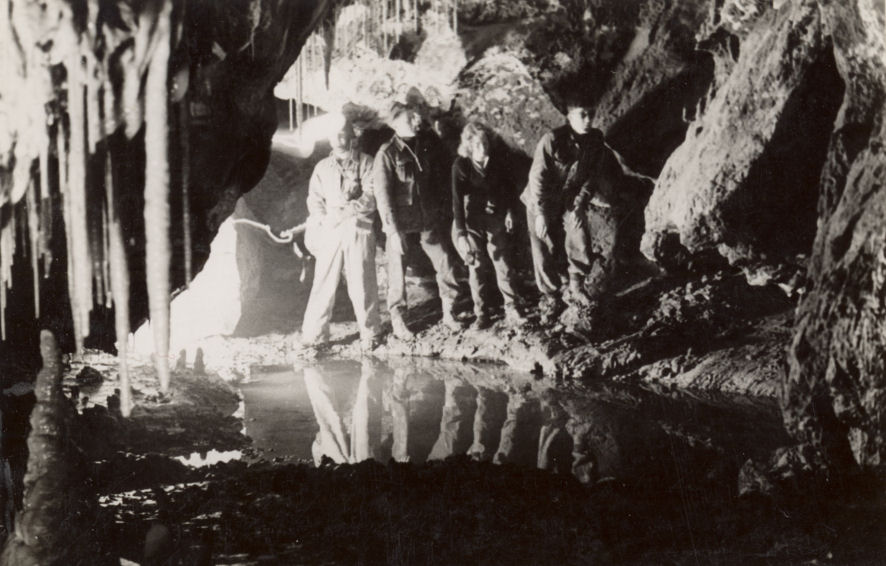
Photo: Tasmanian Caverneering Club surveying the underground river, Newdegate Cave, 1946. (Left to right) Max Stephens, Pat Kirwan, Jessie Luckman, Neil Jones. Photo by Leo Luckman courtesy of Jessie Luckman.
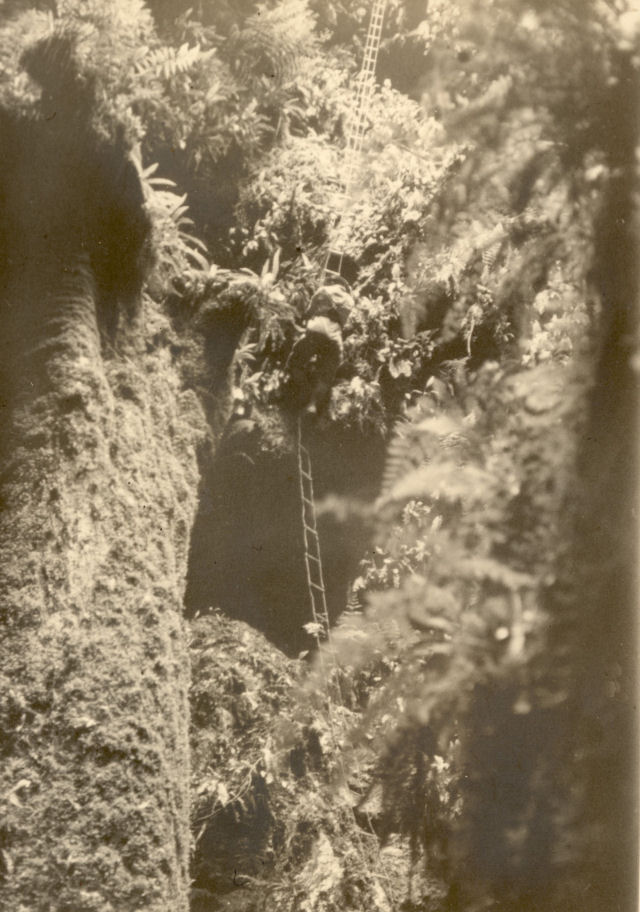
Photo: TCC descending into Erebus Cave, Hastings, probably in 1948. Photo by Ken Iredale.
One remarkable endeavour which did result from this activity, however, was the four-year excavation of the Binney Tunnel. This was dug to provide ‘all weather’ access to new chambers which the TCC found beyond a sump in Newdegate Cave at Hastings. One such chamber was christened the Mystery Chamber, because it contained ‘mysteries’ or helictites, which fascinated early cavers. The Binney Tunnel also opened the Binney Chambers or Caves — both features being named after Tasmanian Governor Sir Hugh Binney, who was the club’s patron. The excavation was painstaking, cavers being able to work only five or ten-minute shifts by candle light with a restricted oxygen supply in the cramped conditions.19
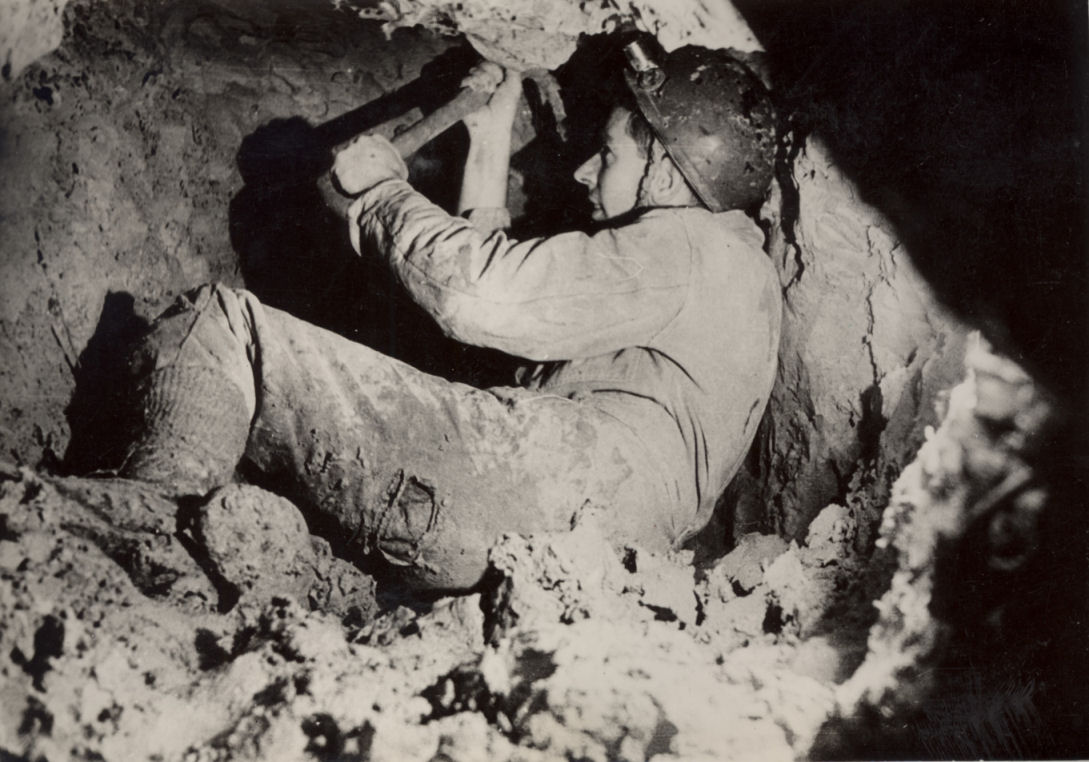
Photo: Ken Iredale digging in the Binney Tunnel, Newdegate Cave, some time in the period 1948-50. Photo by Leo Luckman courtesy of Jessie Luckman.
Finally, in September 1950, the Binney Tunnel was ready to accommodate Sir Hugh Binney himself. The Governor was not very sprightly, but it was reasoned that his performance in the confined space might be improved by placing two female cavers in front of him. Sure enough, Binney’s refusal to be upstaged by ladies spurred him to squeeze through the tunnel. TCC secretary Ken Iredale had the pleasure of pulling the Governor’s leg, quite literally, by hauling him out of the far end and into the Binney Caves.20
Widening horizons
TCC also ventured into the Gunns Plains and Mole Creek districts, exploring the newly discovered Lynds and Croesus Caves near the Mersey River. The club’s means of transport to these areas was an almost asphyxiating World-War-II ‘Blitz Wagon’. In fact, travelling in this vehicle was almost as hazardous as digging the Binney Tunnel, as Jessie Luckman recalled:
It was an awful thing. If you were inside, it sucked up all the exhaust. Sam [Carey] of course drove like a maniac. He never went around corners. He always went through them. They [passengers] would have to be allowed out every now and then to breathe. It was a death-trap…21
Pat Wessing remembered passengers sitting on the wagon’s roof in order to breathe better, their feet dangling through the trapdoor. While travelling through towns, they would duck to avoid the attentions of the police.22 An inflatable rubber raft shared the Blitz Wagon’s roof space.23
Long straws in Lynds, Little Trimmer and Newdegate Caves prompted TCC caver Des Lyons to speculate about world records, but greater revelations awaited.24 In 1954 a TCC party penetrated beyond the entrance chamber of Exit Cave for the first time, beginning the process of exploring a cave system now (in 2009) known to extend more than 30 kilometres. Getting to and from Exit then took most of the weekend, caving being done only on the Saturday evening. The ‘Wind Tunnel’ passage, the remarkable ‘Pendulum’ formation and Exit’s spectacular glow-worm display were unveiled. Rising waters holed the seven-member TCC party up in the same two-person tent made by Jessie and Leo Luckman out of an old parachute — another example of army issue improvisation.25
A notable debutante on that trip, Albert Goede, featured prominently as TCC ventured far and wide. In December 1957, with the aid of airforce-surplus rubber rafts, Goede, Jim Poynter and Frank R Brown were the first to enter and be dazzled by the ‘Pleasure Dome’ in Kubla Khan.26 Two years later a five-man TCC party flew into New River Lagoon one by one to explore caves near Precipitous Bluff. A dickey seat behind the pilot’s was the only passenger accommodation on the ‘one-and-a-half-seater’ Tiger Moth.27 Keen cave photographer Rien de Vries was disappointingly sans camera when he spotted a thylacine beneath the Raglan Range while on a later trip to scout for limestone caves on the Franklin River. 28
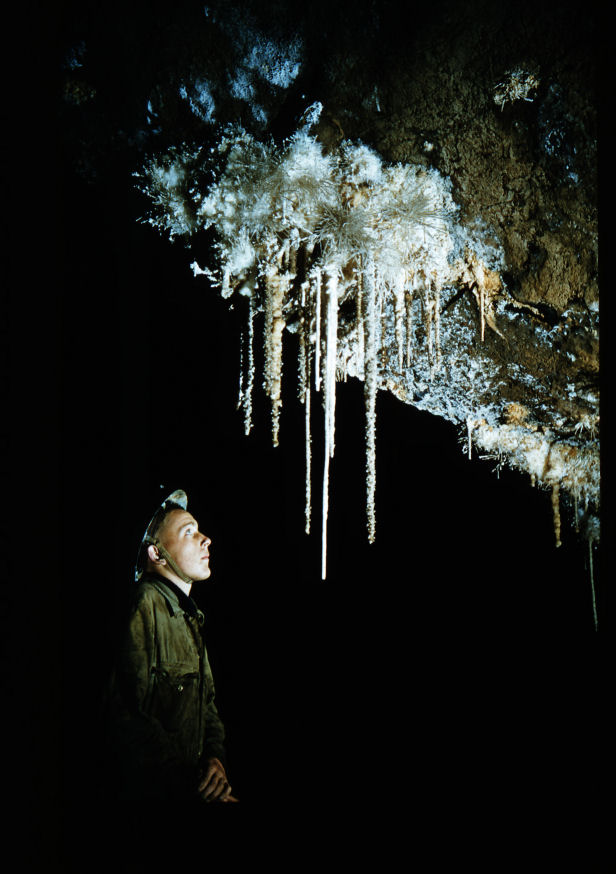
Photo: The discovery of Kubla Khan’s ‘Pleasure Dome’, December 1957. Jim Poynter mesmerised by helictites. Photo by Albert Goede.
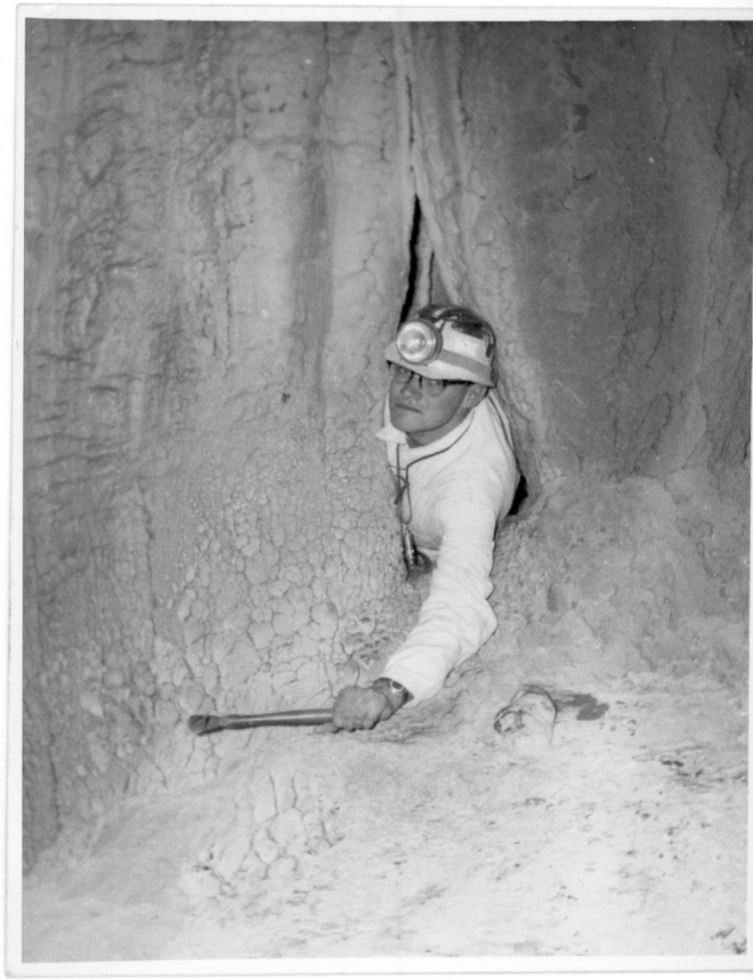
Photo: Albert Goede exploring the ‘Pleasure Dome’, Kubla Khan, December 1957. Photo by Frank R Brown courtesy of Albert Goede.
The Luckmans were among those who eventually renounced caving for hiking. ‘We were much more interested in being out in the sun’, Jessie recalled, ‘and left the caving to the caverneers…’29 Optometrist Ken Iredale, who spent his working day in an office, likewise opted for wide open spaces over tight subterranean squeezes.30 The development of specialised interests such as cave biology, hydrology and cave photography encouraged others to stick with the underground sport. In these specialised fields, amateurs entered a realm previously dominated by professionals. ‘… we want to find the new stuff [undiscovered caves]’, wrote the editors of the 1963 TCC Caverneering Handbook,
but if you prefer to take photographs or do serious studies of the hydrology or biology of caves we’ll welcome you with open arms too.31
Just as caving and hiking were allied, TCC overlapped membership with the Tasmanian Field Naturalists’ Club, established in 1904. Sam Carey, Max Banks, Jessie Luckman, David Elliott and Rhona Warren were among those who joined both clubs.32 TCC members began collecting cave fauna at Mystery Creek Cave in 1947, but some years passed before speleos became serious collectors of Tasmanian cave fauna.33 The first to do so were Elery Hamilton-Smith, the husband and wife team of Albert and Therese Goede, and Bob Cockerill. Hamilton-Smith’s articles and Aola Richards’ introductory paper describing JR Schiner’s ecological classification of cave animals, together with the cave zones and habitats proposed by René Jeannel, encouraged development of this interest.34
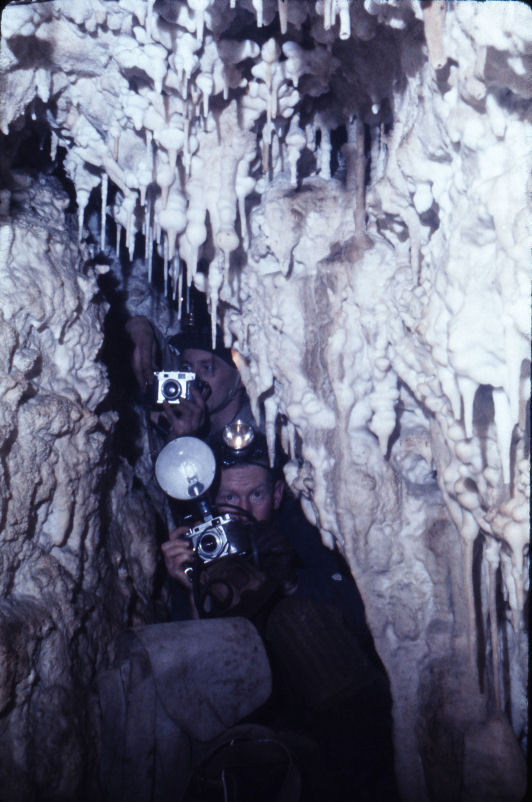
Photo: ‘Photrogs’ in Baldocks Cave, 1963. Photo by Bob Woolhouse courtesy of Gill and Keith Chapman.
From its early days, photography had a social and documentary role in outdoor recreation. The visual recording of events, achievements and camaraderie has bonded sporting club members and helped generate a club identity. Some adventure sportsmen took their interest in photography further, however, recognising the opportunities afforded by being ‘on location’ which were denied the non-sporting professional photographer.
With the advent of recreational caving, cave photography became much more dynamic. What cavers lacked in technical camera skills, they gained in spontaneous action subject matter: the frightening descent of a steep pitch, for example, or an awe-struck caver locked in a moment of discovery. Photography also became more user-friendly in the post-war period. Flash powder, with its potentially explosive and frequently suffocating results, had long been the chief source of underground illumination. Flash sheets, a paper form of flash powder, magnesium ribbon and, eventually, the entirely smokeless flash bulbs improved the accuracy of exposures. Electronic flash units were cheaper, but dangerous to operate in damp cave conditions and unsuitable for producing the Kodachrome or Ektachrome colour transparencies which were now favoured.35 Ken Iredale and Rien de Vries were among the first TCC cavers to embrace colour photography, with Mole Creek cave exploration their central theme.
The young guns of Launceston
In 1961 a Northern Branch of TCC was established in Launceston by a British immigrant with overseas caving experience, Bob Woolhouse, and Brian Duhig. It differed from its parent body in that none of its early members were hikers. TCC Northern Branch had a significant membership cross-over, however, with the Northern Alpine Club. Cavers such as Ralph Power, Bob Yates, Noel Barratt, David Barratt, Ian Gasking and Gerald Lewis represented the Alpine Club’s new guard during the 1960s.36 Interest in geology, hydrology and fauna infused Northern Branch caving from its outset. Teenager Paul AC Richards, for instance, experimented with exposing an x-ray plate by glow-worm light, and marvelled at the development of ‘cave pearls’ in Croesus Cave’s gour pools.37 Improvisation and a sense of being pioneers characterised the new branch just as it did the established one. Ladders were manufactured from durallium and wire on a template in Frank C Brown’s back yard. The photographic team of Woolhouse and Brown improvised an effective flash system — a ‘flash gun’, as they called it — out of an old army torch which fitted onto Brown’s helmet. When Brown ‘saluted’, as he put it, he triggered a button on his visor, which illuminated Woolhouse’s camera shot. The pair concentrated on capturing caving action — and there was plenty of that.38

Photo: Bob Woolhouse at the entrance to Little Trimmer Cave, Mersey River. Photo by Frank C Brown.

Photo: TCC Northern Branch exploring a flooded Hidden Cave, 1963. Photo by Bob Woolhouse courtesy of Gill and Keith Chapman.
One of the Northern Branch’s first exploration targets was Marakoopa Cave beyond the tourist section. In 1963 three Northern Branch members, Bob Yates, Gerald Lewis and Ralph Power, were trapped in the sump known as the Fireplace at Marakoopa for 12 hours when it flooded.39 At around the same time, Rover Scouts associated with the club verified the top entrance to Croesus Cave — by shooting a hole through it with a pistol from inside the cave.40
The dolines around Devils Pot in the foothills of the Great Western Tiers were so enormous that, as Bob Woolhouse put it, ‘the normal clues for navigating about sloping ground don’t work’. Dolines dropped away to ‘great holes’. They were so steep that the old eucalypt forest they contained had escaped logging. Consequently the eucalypts were dying, leaving a criss-cross of massive trunks for the explorers to stumble over.41 On the club’s first Devils Pot trip only the roar of its waterfall led the cavers through the sleet. Bob Woolhouse recalled that
We got down until things began to seem a little dicey and then we put a rope on Gaskin [sic] and sent him to see what happened. He got down another 80 feet or so [about 25 metres] until he looked over a ledge and saw a possum below him. The possum stepped backwards, missed the ledge and somersaulted slowly out of sight. It was a long time before it hit anything. We retired rather shaken.42
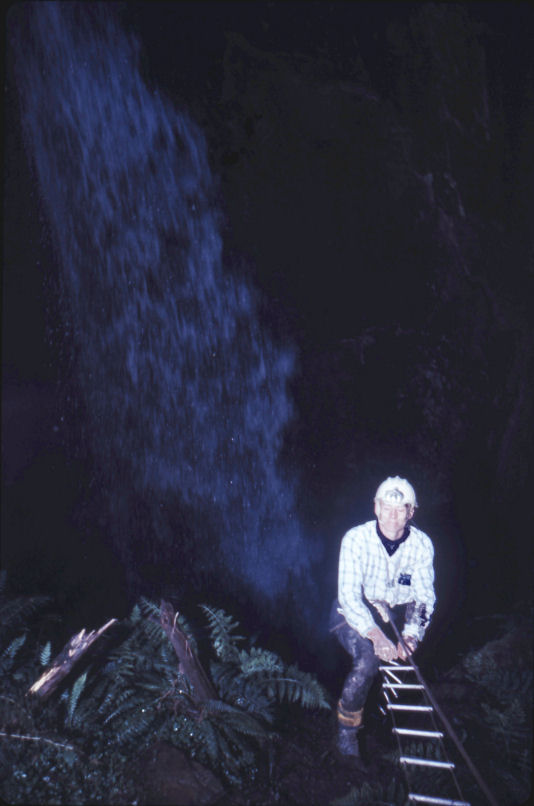
Photo: TCC Northern Branch descending into Devils Pot. Photo by Bob Woolhouse courtesy of Gill and Keith Chapman.
In 1965 Woolhouse descended the first pitch in the vertical shaft known as Execution Pot. Progress beyond this pitch depended on him being able to widen a small hole at its base with a crowbar. Woolhouse outlined the circumstances of his failure to do so in the club magazine Troglodyte:
11.35 Woolhouse clears large rock from passage, crawls in, clears second rock and pauses for breath
11.40 Realises he is not alone and goes from prone position to halfway up ladder in one graceful movement. Snake goes 4ft up wall where stopped by small overhang.
11.45 Woolhouse half way up ladder, snake 4ft up wall. Look at one another. Impasse...
12.10 Ford & Sterling push Wilkie down ladder armed with 3lb hammer.
12.20 Wilkie confirms existence of snake.
12.30 Poke snake off wall with long stick. Snake rears and announces it is a tiger.43
The tiger was tamed with the hammer, after which gelignite was invoked to clear the rock obstruction. When that failed to do the job, club member Ralph Power mysteriously produced two slabs of TNT. Troglodyte recorded the conversation as Paul AC Richards and Power placed the charge in the suitably-named Execution:
Ralph and Paul at the bottom of Execution
Paul: How many slabs are you going to use Ralph?
Ralph: The whole flamin’ lot mate.
Paul: Hell you’ll blow up Mole Creek mate.
Ralph: Yeh what a pity, should stir them up a bit.
Paul: OK, you know what you’re doing mate.
Ralph turns back for 0.1 second, to find that Paul is half way up ladder.44
With 9 metres of fuse and a 12-metre ladder climb to escape from the shaft, fellow TCC members retreated to the rim and watched while Power set off the charge. He lived up to his name. The blast rocked eucalypts on the surface and produced a hole cavers could enter, with a 60-metre drop beneath it. The cave system below was very disappointing, however, and the club never went back.45

Photo:TCC Northern Branch’s first attempt to blast through the entrance pitch of Execution Pot, Mole Creek, in May 1966. Fusing the gelignite.

Richard Porch and Noel Barratt lay the charge.

The blast shifted only a small volume of rock, necessitating further explosions. Above Photos by Bob Woolhouse courtesy of Gill and Keith Chapman.
Longneck challenge
Meanwhile, Ida Bay still challenged TCC’s original Hobart-based branch. Inaccessibility frustrated Exit Cave’s exploration. The cutting of the ‘Kokoda Trail’ over Marble Hill to the cave in 1959 reduced the approach time to six hours, but Dennis Seymour demanded better, posting a reward of two dozen longnecks (two slabs of beer) for the discoverer of a route through Mystery Creek Cave into Exit.
The cutting of a shorter external access track, the so-called ‘Brooker Highway’, by cavers in 1966 encouraged exploration beyond Exit’s ‘Rockfall’. With an estimate that only 1200 feet (about 360 metres) now separated explored passages from the far end of Mystery Creek Cave, imminent bacchanalia seemed assured.46
An astonishing find kept cavers sober. The establishment of Camp 2 inside Exit led to the discovery of the ’Mini Martin’ vertical entrance to the cave, when a caver realised that the ‘rock’ he was sitting on was actually a fallen tree trunk — perhaps 150 metres below the surface. A scramble in the rainforest above by Brian and Jeanette Collin revealed the shaft opening. In August 1967 two TCC members, Allan Keller and John Marshall, set a new Australian depth record of 720 feet (about 220 metres) by descending ‘Mini Martin’ into Exit Cave.47
In February 1968 the hydrological link between Exit and Mystery Creek Caves was finally established when six pounds of green fluorescein dye released into Mystery Creek emerged from Exit.48 In October of that year a tight squeeze discovered inside Mystery Creek Cave was marked by a matchbox — hence its name ‘Matchbox Squeeze’. Suspicion of a vertical connection led cavers to scour the hill outside for an entrance they descended by ladder. ‘Midnight Hole’ recalls the late hour at which they found the same matchbox — and ‘Matchbox Squeeze’ —at the base of this daunting drop.49 Not even a bottle could squeeze through the Exit-Mystery Creek dye channel, however, and only the sound of one longneck clinking toasts the 50th birthday of Dennis Seymour’s unclaimed reward.
Exit wounds
In 1967 Tasmania’s Hydro-Electric Commission announced that it planned what some considered the greatest vandalism ever perpetrated upon the state: the flooding of Lake Pedder. Preserving and protecting this lake soon became a defining showdown for many Tasmanians — and not just hikers or those who had previously considered themselves conservationists. If Gallipoli blooded Australian nationhood, the Lake Pedder debate blooded Green Tasmania.
The TCC was already campaigning to protect karst. Its charter, after all, included preservation of caves and protecting them from vandalism. While these aims may have been submerged sometimes in the dust clearing from gelignite explosions, the fog of despatching fearsome reptiles and the challenge of finding potential new tourist sections in established show caves, ecological awareness within the club was strong and the responsibilities of exploration understood. Unreserved caves such as Croesus and Kubla Khan were gated, best practice caving was encouraged, and, in the Australian Speleological Federation (ASF), club members found a national forum for cave conservation issues. The ecological impact of Tasmania’s industrial economy had been apparent in karst areas long before the Middle Gordon Power Scheme threatened Lake Pedder.
In 1959 the Ida Bay karst was included in Australian Paper Manufacturers Ltd’s logging concession. The TCC petitioned the Scenery Preservation Board to protect Exit Cave — the scene of astonishing new revelations as exploration intensified from the mid 1960s.50 The proposal for an Exit Cave State Reserve, though, was an opening gambit in one of Australia’s longest conservation disputes, one extending far beyond the bounds of caving clubs and beyond the scope of this paper.
Sam Carey had trained his commandos in the use of caves as a base for covert operations behind enemy lines.51 Their training ground, the Mount Etna Caves, was later damaged by a peace-time ‘enemy’, limestone mining. Similarly, for years the karst environment of Exit Cave rocked to blasts from an encroaching quarry. The cave’s deliverance from industry proved that political savvy, smart science, media skills and, above all, a ‘greener’ public were the keys to winning the modern conservation ‘war’.
References
Peter Thompson and Robert Macklin, Kill the Tiger: The Truth About Operation Rimau, Hodder Australia, Sydney, 2002, pp.59-60; Alan Powell, War by Stealth: Australians and the Allied Intelligence Bureau 1942-1945, Melbourne University Press 1996, p.65
Alan Powell, War by Stealth: Australians and the Allied Intelligence Bureau 1942-1945, Melbourne University Press 1996, p.197
Patrick G Quilty and Maxwell R Banks, ‘Biographical Memoirs: Samuel Warren Carey, 1911-2002’ (originally published in Historical Records of Australian Science, vol.14, no.3, 2003), http://www.science.org.au/academy/memoirs/carey.htm; JK Sprent (ed), Mount Etna Caves, University of Queensland Speleological Society, St Lucia, Qld, 1970, p.86. Thanks to Rhonwen and Miles Pierce.
Interview with Jessie Luckman 5 February 2009
Speleo Spiel (journal of the Tasmanian Caverneering Club), issue 1, AA494/108 483/1/46 ‘Caverneering in Tasmania’ (Archives Office of Tasmania)
For Carey’s ‘underground wonders’ speech, see minutes of meeting of Tasmanian Field Naturalists Club 20 June 1946, NS 689/1-111 (Archives Office of Tasmania).
See, for example, Max Angus, The World of Olegas Truchanas, Olegas Truchanas Publication Committee, Hobart, 1975, p.15.
Bob Brown, ‘Peter Dombrovskis’, in Dombrovskis: A Photographic Collection, West Wind Press, Hobart, 1998, pp.6-9
Johnson Dean, Shooting the Franklin: Early Canoeing on Tasmania's Wild Rivers, Evandale, Tasmania, 2002, pp.13-47. For earlier Tasmanian canoeing and kayaking, see, for example, ‘Lake St Clair to Glenora: a Hazardous Canoe Trip: Unexplored Country Traversed’, Illustrated Tasmanian Mail 25 February 1925, pp.18-20; or ‘Canoe Wanderer: Overland from Burnie to Zeehan: A Unique Treck’ [sic], Advocate 4 April 1932 p.8.
For Carey recruiting cavers from the Tasmanian Field Naturalists Club (TFNC), for example, see minutes of TFNC meeting 20 June 1946, NS689/1-111 (Archives Office of Tasmania).
Max Angus, The World of Olegas Truchanas, Olegas Truchanas Publication Committee, Hobart, 1975, p.18
Interview with Paul AC Richards 27 April 2009
Federation Peak’, Jessie Luckman, RN Smith and Leo Luckman, Tasmanian Tramp, no.8, October 1948, pp.16-23
JB Thwaites, ‘In the Footsteps of Sir John Franklin (A Journey Through Western Tasmania)’, Walkabout 1 December 1955, pp.29-32
Leo Luckman and Rhona Warren were elected life members of the Hobart Walking Club in 1950. In 1935 a Hobart Walking Club party including Warren had searched unsuccessfully for ‘lost’ caves on Mount Hull near Hobart (Rhona Warren, ‘Lost Caves’, Tasmanian Tramp no.4, December 1935, pp.27-29).
Pat Wessing, ‘Reminiscences of Early Caverneering — or You Young Ones Don't Know How Good You've Got it, Gear Wise!’, Speleo Spiel no.223, December 1986, pp.2-4
Interview with Jessie Luckman 5 February 2009
Tasmania’s fourth show cave, Gunns Plains, was then leased by the Ulverstone Tourists Association from the Scenery Preservation Board, an advisory body to government on conservation matters which had few powers.
Interview with Ken Iredale 5 February 2009
Interview with Jessie Luckman 5 February 2009
Interview with Jessie Luckman 5 February 2009
Pat Wessing, ‘Reminiscences of early caverneering — or you young ones don't know how good you've got it, gear wise!’, Speleo Spiel no.223, December 1986, pp.2-4
Interview with Ken Iredale 5 February 2009
GD Lyons, ‘Tasmanian Caverns Claim World Records’, Wild Life December 1950 pp.545-51
Interview with Jessie Luckman 5 February 2009
Interview with Albert Goede 21 August 2008. See also ‘
Interview with Albert Goede 21 August 2008
Interview with Rien de Vries 8 January 2009
Interview with Jessie Luckman 5 February 2009
Interview with Ken Iredale 5 February 2009
Foreword (by eds GR Lewis, JB Long and Bob Woolhouse), Caverneering Handbook of the Tasmanian Caverneering Club, 1963, p.1
Janet Fenton, A Century Afield: a History of the Tasmanian Field Naturalists Club, TFNC, Hobart, 2004
Albert Goede, ‘Tasmanian Cave Fauna: Character and Distribution’, Helictite, vol.5, no.4, July 1967, pp.71-86
Elery Hamilton-Smith, ‘Cave-Wetas or Cave-Locusts’, and ‘Identification of Biological Material’, ASF Newsletter, No. 1, June 1957, p.1; Aola M Richards, ‘Cave Animals and Their Environment’, Helictite, vol.1, no.1, October 1962, pp.3-13
Tasmanian Caverneering Club Handbook, Hobart, 1953, pp.67-68
For the Northern Alpine Club during the 1960s, see David M Harvey, The Ben Lomond Story, 2000, pp.80-105.
Interviews with Paul AC Richards 27 April and 20 May 2009; Paul AC Richards’ 1963 journal
Interview with Frank C Brown 4 December 2008. For a technical description of the ‘capacitator flash firer’ see Caverneering Handbook of the Tasmanian Caverneering Club, 1963, pp.21-25.
Men Saved from Cave: Launceston Trio Have Lucky Escape’, Examiner 5 November 1992, p.9
Bob Woolhouse and Compton Allen, ‘A Brief History of the Northern Caverneers’, July 1984
Interview with Bob Woolhouse 2003
Bob Woolhouse, ‘My Life and Times: no.4: Marakoopa System’, Troglodyte no.5, p.13
Bob Woolhouse, ‘My Life and Times in the Northern Branch: no.1: Execution Pot’, Troglodyte no.1, 1966, unpaginated
Troglodyte no.3, 1966, unpaginated
Interview with Paul Richards 27 April 2009
Editorial, Speleo Spiel, December 1966, p.1
Albert Goede, ‘Descent of Mini Martin’, Rucksack no.2 (May-June 1968), pp.1-4; editorial, Speleo Spiel July 1967 p.1
Editorial, Speleo Spiel, March 1968, p.1
Editorial, Speleo Spiel, November 1968 p.1
File ‘Exit Cave 1973-4’, AA900/1/34 200/28 (Archives Office of Tasmania)
JK Sprent (ed), Mount Etna Caves, University of Queensland Speleological Society, St Lucia, Qld, 1970, p.86